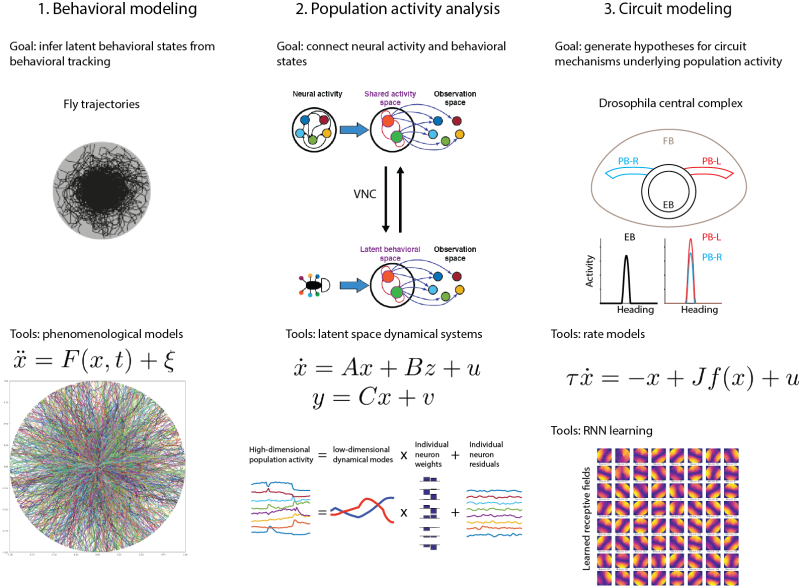Back to U19 Main Page
U19 Project: Modeler: Shaul Druckmann, Stanford; Richard Murray, Caltech, PI:Dickinson.
Summary:
Our Project team’s long-term goal is to develop a comprehensive theory of animal behavior that explicitly incorporates neural processes operating across hierarchical levels — from circuits that regulate the action of individual muscles to those that regulate behavioral sequences and decisions. Our innovative approach is guided by the notion that different brain regions are not linked within a single neuroanatomical tier, but rather constitute a series of hierarchically nested feedback loops. The effort is organized into four Research Projects, each focusing on a different processing stage related to: (1) muscle action, (2) motor patterns, (3) motion guidance, and (4) behavioral sequences. Demonstrating our commitment to team interaction, these Research Projects are not organized according to PIs laboratories, but rather each constitutes a collaborative multi-laboratory effort. The collective expertise of our research team spans the entire nervous system - from the sensory periphery to the motor periphery and was chosen to include experts in every experimental technique we require (molecular genetics, electrophysiology, optical imaging, biomechanics, quantitative behavioral analysis, control theory, and dynamic network theory). We will exploit mathematical approaches – control theory and dynamic network theory in particular – that are best suited to model feedback and the flow of information through and among different processing stages in the brain. The four complimentary and integrated Research Projects will focus on ethologically relevant natural behaviors, with an emphasis on recording methods that interrogate the functions of genetically identified neurons in intact, behaving animals – a rigorous standard that is designed to have the broadest impact on systems neuroscience. Our research exploits a single, experimentally tractable model system (Drosophila melanogaster), in which we can easily study the functions of genetically identified cell classes in ethologically relevant behaviors. Our experiments emphasize methods that interrogate the functions of neurons in intact, behaving animals, a rigorous standard that is designed to have the broadest impact on systems neuroscience. Our research will be supported by an Instrumentation and Software Resource Core that will develop and support novel devices and software, so that we can continue to employ state-of-the-art experimental techniques and data analysis. Collectively, our research program constitutes a systematic attack on the neural basis of behavior that integrates vertically across phenomenological tiers. The result of our effort will be a new synthesis of how a fully embodied brain works to generate behavior.

Other Materials
CNN_particle_swarm_tracking_0.avi
Data/Model Re-use: Dissecting distributed representations by advanced population activity analysis methods and modeling EB028171
2021 Brain PI Meeting Demo
Presenter: Pierre Karashchuk (Tuthill Lab, UW, FlyLoops U19)
Demo: Tools for automated tracking and visualization of 3D animal behavior with DeepLabCut and Anipose: Slides
Brochure: Anipose Preprint
Back to U19 Main Page

